Demonstration of Tunable Shielding Effectiveness in GHz and THz Bands for Flexible Graphene/Ion Gel/Graphene Film
Abstract
:1. Introduction
2. Principle Analysis and Modelling
2.1. Principle Analysis
2.2. Modelling and Fabrication
3. Demonstration of Tunable Shielding Effectiveness in GHz Bands
3.1. Design and Experiments of Different Shielding Film Structures
3.1.1. Definition of Shielding Effectiveness
3.1.2. The Waveguide Testing Method
3.1.3. Experiments on Shielding Effectiveness of MIM and BIB Structure
3.1.4. Experiments on Shielding Effectiveness of Multilayer MIM Structure
3.2. Dynamic Control of Shielding Effectiveness
3.2.1. Measurement Method
3.2.2. Response Time of Tunability
4. Demonstration of Tunable Shielding Effectiveness in THz Bands
5. Conclusions
Author Contributions
Funding
Institutional Review Board Statement
Informed Consent Statement
Data Availability Statement
Conflicts of Interest
References
- Chung, D.D.L. Electromagnetic Interference Shielding Effectiveness of Carbon Materials. Carbon 2001, 39, 279–285. [Google Scholar] [CrossRef]
- Watanabe, A.O.; Jeong, S.; Kim, S.; Kim, Y.; Min, J.; Wong, D.; Pulugurtha, M.R.; Mullapudi, R.; Kim, J.; Tummala, R.R. Highly-Effective Integrated EMI Shields with Graphene and Nanomagnetic Multilayered Composites. In Proceedings of the 2016 IEEE 66th Electronic Components and Technology Conference (ECTC), Las Vegas, NV, USA, May 31–1 June 2016; pp. 206–210. [Google Scholar]
- Kim, K.; Koo, K.; Hong, S.; Kim, J.; Cho, B.; Kim, J. Graphene-Based EMI Shielding for Vertical Noise Coupling Reduction in 3D Mixed-Signal System. In Proceedings of the 2012 IEEE 21st Conference on Electrical Performance of Electronic Packaging and Systems, Tempe, AZ, USA, 21–24 October 2012; pp. 145–148. [Google Scholar]
- Liu, L.; Kong, L.B.; Yin, W.-Y.; Matitsine, S. Characterization of Single- and Multiwalled Carbon Nanotube Composites for Electromagnetic Shielding and Tunable Applications. IEEE Trans. Electromagn. Compat. 2011, 53, 943–949. [Google Scholar] [CrossRef]
- Li, N.; Huang, Y.; Du, F.; He, X.; Lin, X.; Gao, H.; Ma, Y.; Li, F.; Chen, Y.; Eklund, P.C. Electromagnetic Interference (EMI) Shielding of Single-Walled Carbon Nanotube Epoxy Composites. Nano Lett. 2006, 6, 1141–1145. [Google Scholar] [CrossRef] [PubMed]
- Wang, Y.; Jing, X. Intrinsically Conducting Polymers for Electromagnetic Interference Shielding. Polym. Adv. Technol. 2005, 16, 344–351. [Google Scholar] [CrossRef]
- Liu, M. Four-Layer Tunable Wideband Electromagnetic Shield Based on Cold Plasma. IEEE Access 2020, 8, 171621–171627. [Google Scholar] [CrossRef]
- Wang, G.; Liao, X.; Yang, J.; Tang, W.; Zhang, Y.; Jiang, Q.; Li, G. Frequency-Selective and Tunable Electromagnetic Shielding Effectiveness via the Sandwich Structure of Silicone Rubber/Graphene Composite. Compos. Sci. Technol. 2019, 184, 107847. [Google Scholar] [CrossRef]
- Li, X.; Tao, Z.; Hao, B.; Kong, Q.; Liu, Z.; Liu, Z.; Guo, Q.; Liu, L. Reduced Graphene Oxide Bubbles with Tunable Electromagnetic Shielding Effectiveness. Scr. Mater. 2020, 187, 407–412. [Google Scholar] [CrossRef]
- Chen, X.; Tian, Z.; Wang, J.; Yuan, Y.; Zhang, X.; Ouyang, C.; Gu, J.; Han, J.; Zhang, W. Hysteretic Behavior in Ion Gel-Graphene Hybrid Terahertz Modulator. Carbon 2019, 155, 514–520. [Google Scholar] [CrossRef]
- D’Aloia, A.G.; D’Amore, M.; Sarto, M.S. Terahertz Shielding Effectiveness of Graphene-Based Multilayer Screens Controlled by Electric Field Bias in a Reverberating Environment. IEEE Trans. THz Sci. Technol. 2015, 5, 628–636. [Google Scholar] [CrossRef]
- Baek, I.H.; Ahn, K.J.; Kang, B.J.; Bae, S.; Hong, B.H.; Yeom, D.-I.; Lee, K.; Jeong, Y.U.; Rotermund, F. Terahertz Transmission and Sheet Conductivity of Randomly Stacked Multi-Layer Graphene. Appl. Phys. Lett. 2013, 102, 191109. [Google Scholar] [CrossRef]
- Sensale-Rodriguez, B.; Fang, T.; Yan, R.; Kelly, M.M.; Jena, D.; Liu, L.; (Grace) Xing, H. Unique Prospects for Graphene-Based Terahertz Modulators. Appl. Phys. Lett. 2011, 99, 113104. [Google Scholar] [CrossRef] [Green Version]
- Lv, H.; Yang, Z.; Ong, S.J.H.; Wei, C.; Liao, H.; Xi, S.; Du, Y.; Ji, G.; Xu, Z.J. A Flexible Microwave Shield with Tunable Frequency-Transmission and Electromagnetic Compatibility. Adv. Funct. Mater. 2019, 29, 1900163. [Google Scholar] [CrossRef]
- Liu, J.; Qian, Q.; Zou, Y.; Li, G.; Jin, Y.; Jiang, K.; Fan, S.; Li, Q. Enhanced Performance of Graphene Transistor with Ion-Gel Top Gate. Carbon 2014, 68, 480–486. [Google Scholar] [CrossRef]
- Shen, B.; Li, Y.; Yi, D.; Zhai, W.; Wei, X.; Zheng, W. Strong Flexible Polymer/Graphene Composite Films with 3D Saw-Tooth Folding for Enhanced and Tunable Electromagnetic Shielding. Carbon 2017, 113, 55–62. [Google Scholar] [CrossRef]
- Yang, C.; Li, H.; Cao, Q.; Wang, Y. Switchable Electromagnetic Shield by Active Frequency Selective Surface for LTE-2.1 GHz. Microw. Opt. Technol. Lett. 2016, 58, 535–540. [Google Scholar] [CrossRef]
- Zhang, J.; Lin, M.; Wu, Z.; Ding, L.; Bian, L.; Liu, P. Energy Selective Surface With Power-Dependent Transmission Coefficient for High-Power Microwave Protection in Waveguide. IEEE Trans. Antennas Propag. 2019, 67, 2494–2502. [Google Scholar] [CrossRef]
- Gianvittorio, J.P.; Zendejas, J.; Rahmat-Samii, Y.; Judy, J. Reconfigurable MEMS-Enabled Frequency Selective Surfaces. Electron. Lett. 2002, 38, 1627. [Google Scholar] [CrossRef]
- Li, Y.; Zhang, S.; Ni, Y. Graphene Sheets Stacked Polyacrylate Latex Composites for Ultra-Efficient Electromagnetic Shielding. Mater. Res. Express 2016, 3, 075012. [Google Scholar] [CrossRef]
- Bao, Q.; Loh, K.P. Graphene Photonics, Plasmonics, and Broadband Optoelectronic Devices. ACS Nano 2012, 6, 3677–3694. [Google Scholar] [CrossRef]
- Chen, X.; Tian, Z.; Li, Q.; Li, S.; Zhang, X.; Ouyang, C.; Gu, J.; Han, J.; Zhang, W. Recent Progress in Graphene Terahertz Modulators. Chinese Phys. B 2020, 29, 077803. [Google Scholar] [CrossRef]
- Hong, S.K.; Kim, K.Y.; Kim, T.Y.; Kim, J.H.; Park, S.W.; Kim, J.H.; Cho, B.J. Electromagnetic Interference Shielding Effectiveness of Monolayer Graphene. Nanotechnology 2012, 23, 455704. [Google Scholar] [CrossRef] [PubMed]
- He, X.; Kim, S. Graphene-Supported Tunable Waveguide Structure in the Terahertz Regime. J. Opt. Soc. Am. B 2013, 30, 2461. [Google Scholar] [CrossRef]
- Sensale-Rodriguez, B.; Yan, R.; Kelly, M.M.; Fang, T.; Tahy, K.; Hwang, W.S.; Jena, D.; Liu, L.; Xing, H.G. Broadband Graphene Terahertz Modulators Enabled by Intraband Transitions. Nat. Commun. 2012, 3, 780. [Google Scholar] [CrossRef] [PubMed]
- Polat, E.O.; Kocabas, C. Broadband Optical Modulators Based on Graphene Supercapacitors. Nano Lett. 2013, 13, 5851–5857. [Google Scholar] [CrossRef] [PubMed]
- Kakenov, N.; Balci, O.; Polat, E.O.; Altan, H.; Kocabas, C. Broadband Terahertz Modulators Using Self-Gated Graphene Capacitors. J. Opt. Soc. Am. B 2015, 32, 1861. [Google Scholar] [CrossRef] [Green Version]
- Balci, O.; Kakenov, N.; Karademir, E.; Balci, S.; Cakmakyapan, S.; Polat, E.O.; Caglayan, H.; Özbay, E.; Kocabas, C. Electrically Switchable Metadevices via Graphene. Sci. Adv. 2018, 4, eaao1749. [Google Scholar] [CrossRef] [Green Version]
- Zhang, J.; Wei, X.; Rukhlenko, I.D.; Chen, H.-T.; Zhu, W. Electrically Tunable Metasurface with Independent Frequency and Amplitude Modulations. ACS Photonics 2020, 7, 265–271. [Google Scholar] [CrossRef]
- Kakenov, N.; Ergoktas, M.S.; Balci, O.; Kocabas, C. Graphene Based Terahertz Phase Modulators. 2D Mater. 2018, 5, 035018. [Google Scholar] [CrossRef]
- Balci, O.; Polat, E.O.; Kakenov, N.; Kocabas, C. Graphene-Enabled Electrically Switchable Radar-Absorbing Surfaces. Nat Commun 2015, 6, 6628. [Google Scholar] [CrossRef] [Green Version]
- Zhao, L.; Zhang, R.; Deng, C.; Peng, Y.; Jiang, T. Tunable Infrared Emissivity in Multilayer Graphene by Ionic Liquid Intercalation. Nanomaterials 2019, 9, 1096. [Google Scholar] [CrossRef] [Green Version]
- Zhao, Y. Research on Graphene-based Transparent and Controllable Microwave and Millimeter-wave Devices; Xidian University: Xi’an, China, 2018. (In Chinese) [Google Scholar]
- Liu, P.; Liu, H.; Wang, K. Application of graphene in strong electromagnetic protection technology for ships. Chin. J. Ship Res. 2020, 15, 1–8. (In Chinese) [Google Scholar] [CrossRef]
- Huang, X.; Hu, Z.; Liu, P. Graphene Based Tunable Fractal Hilbert Curve Array Broadband Radar Absorbing Screen for Radar Cross Section Reduction. AIP Adv. 2014, 4, 117103. [Google Scholar] [CrossRef]
- Giuseppe, D.A.; Marcello, D.; Sabrina, S.M. Tunable Graphene/Dielectric Laminate for Adaptive Low-Gigahertz Shielding and Absorbing Screens. IEEE Electromagn. Compat. Mag. 2018, 7, 82–87. [Google Scholar]
- Yao, L.; Liang, Y.; Huang, X.; Hu, S.; Cheng, K.; Liu, J. Dual-Tunable Metamaterial Absorber Based on Solid Ion Gel-Graphene Sandwich Structure. In Proceedings of the AOPC 2020: Display Technology; Photonic MEMS, THz MEMS, and Metamaterials; and AI in Optics and Photonics, Beijing, China, 5 November 2020; Wang, Q., Luo, H., Xie, H., Lee, C., Cao, L., Yang, B., Cheng, J., Xu, Z., Wang, Y., Wang, Y., et al., Eds.; SPIE: Beijing, China, 2020; p. 29. [Google Scholar]
- Song, H.; Liu, J.; Chen, C.; Ba, L. Graphene-based field effect transistor with ion-gel film gate. Acta Phys. Sin. 2019, 68, 097301. (In Chinese) [Google Scholar] [CrossRef]
- Zhu, M.; Yu, L.; He, S.; Hong, H.; Liu, J.; Gan, L.; Long, M. Highly Efficient and Stable Cellulose-Based Ion Gel Polymer Electrolyte for Solid-State Supercapacitors. ACS Appl. Energy Mater. 2019, 2, 5992–6001. [Google Scholar] [CrossRef]
- Aswathi, M.K.; Rane, A.V.; Ajitha, A.R.; Thomas, S.; Jaroszewski, M. EMI Shielding Fundamentals. In Advanced Materials for Electromagnetic Shielding; John Wiley & Sons, Ltd.: Hoboken, NJ, USA, 2018; pp. 1–9. ISBN 978-1-119-12862-5. [Google Scholar]
- Daniel, S.; Thomas, S. Shielding Efficiency Measuring Methods and Systems. In Advanced Materials for Electromagnetic Shielding; John Wiley & Sons, Ltd.: Hoboken, NJ, USA, 2018; pp. 61–87. ISBN 978-1-119-12862-5. [Google Scholar]
- Yu, J.; Wang, X.; Ding, E.; Jing, J. A Novel Method of On-Line Coal-Rock Interface Characterization Using THz-TDs. IEEE Access 2021, 9, 25898–25910. [Google Scholar] [CrossRef]
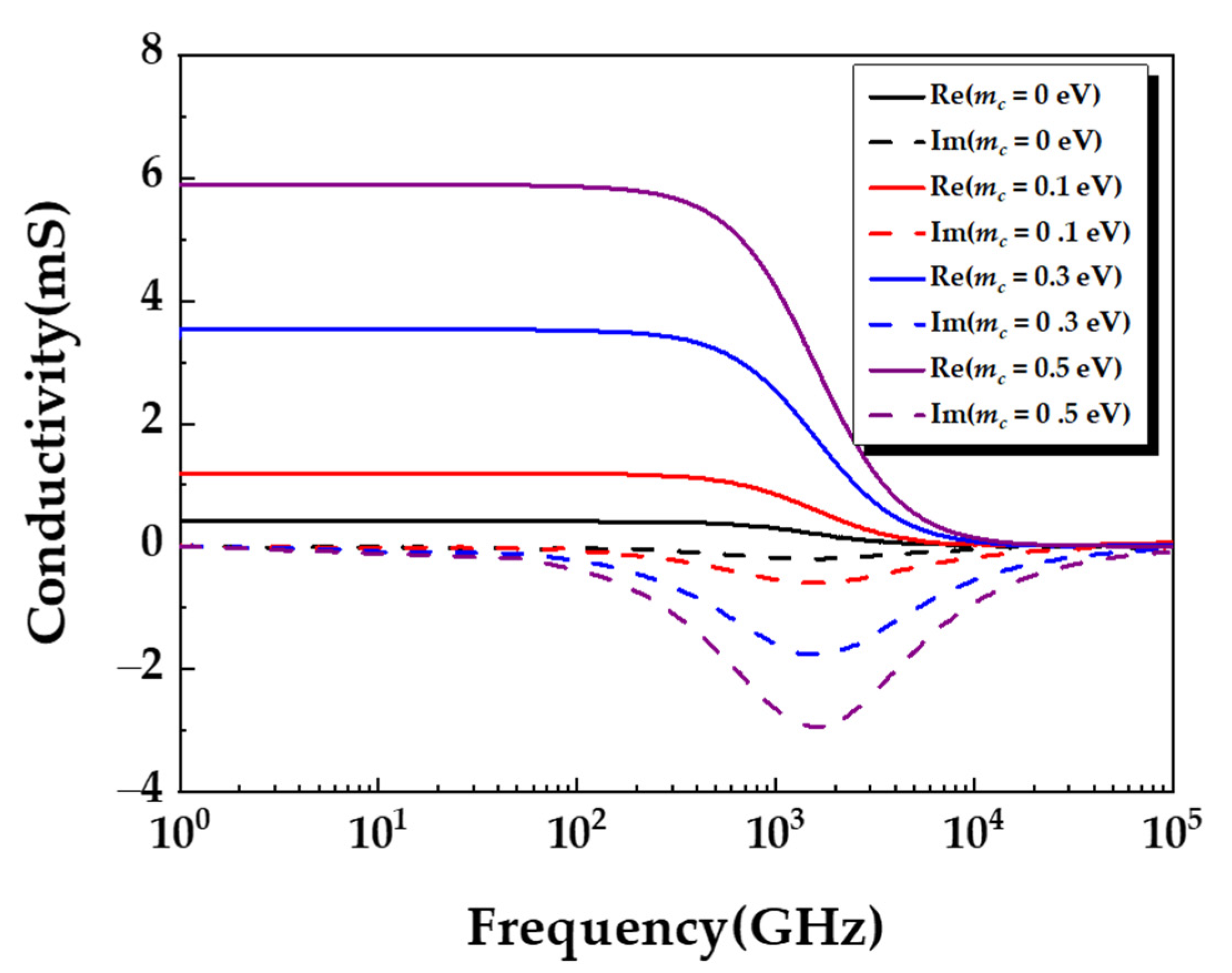
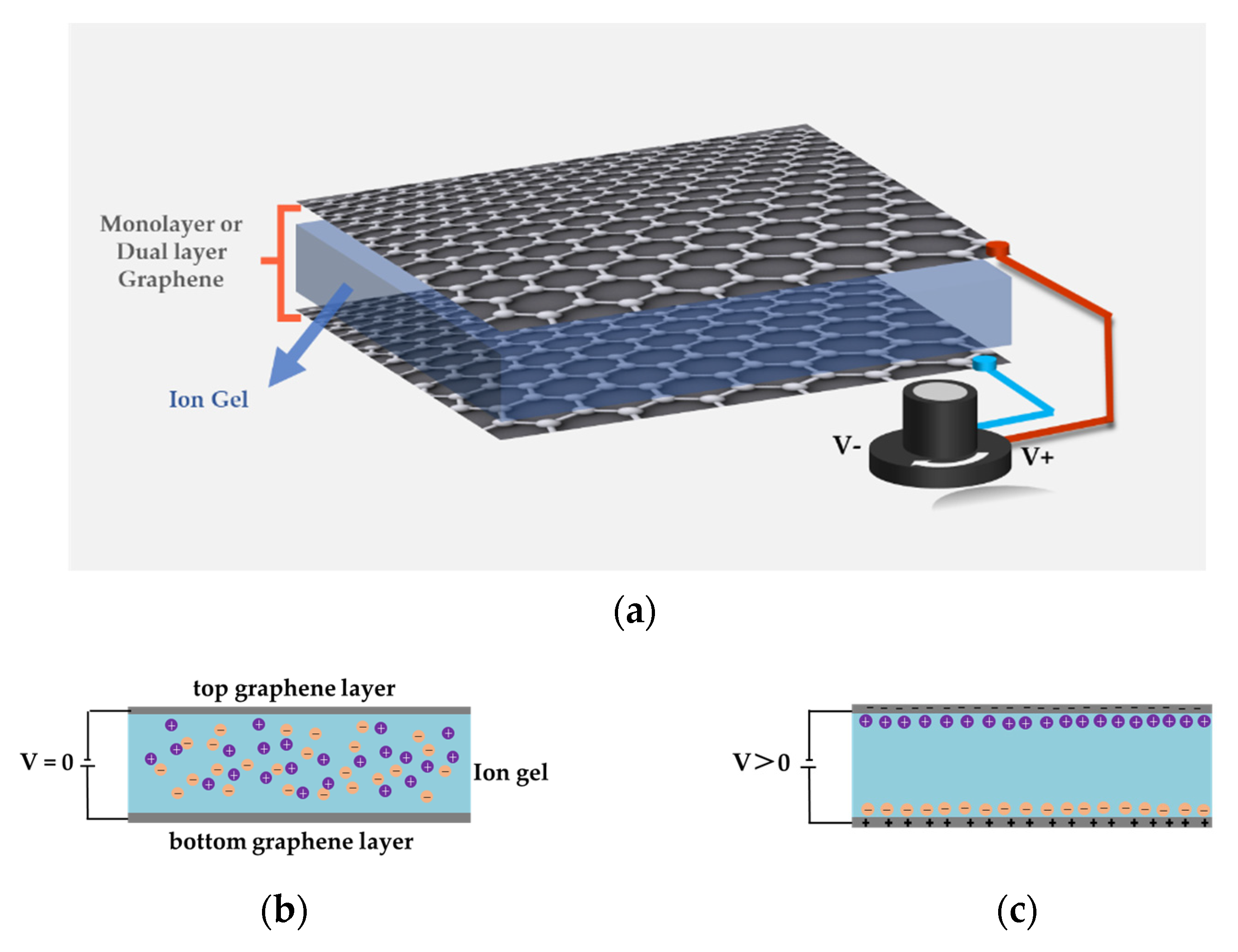
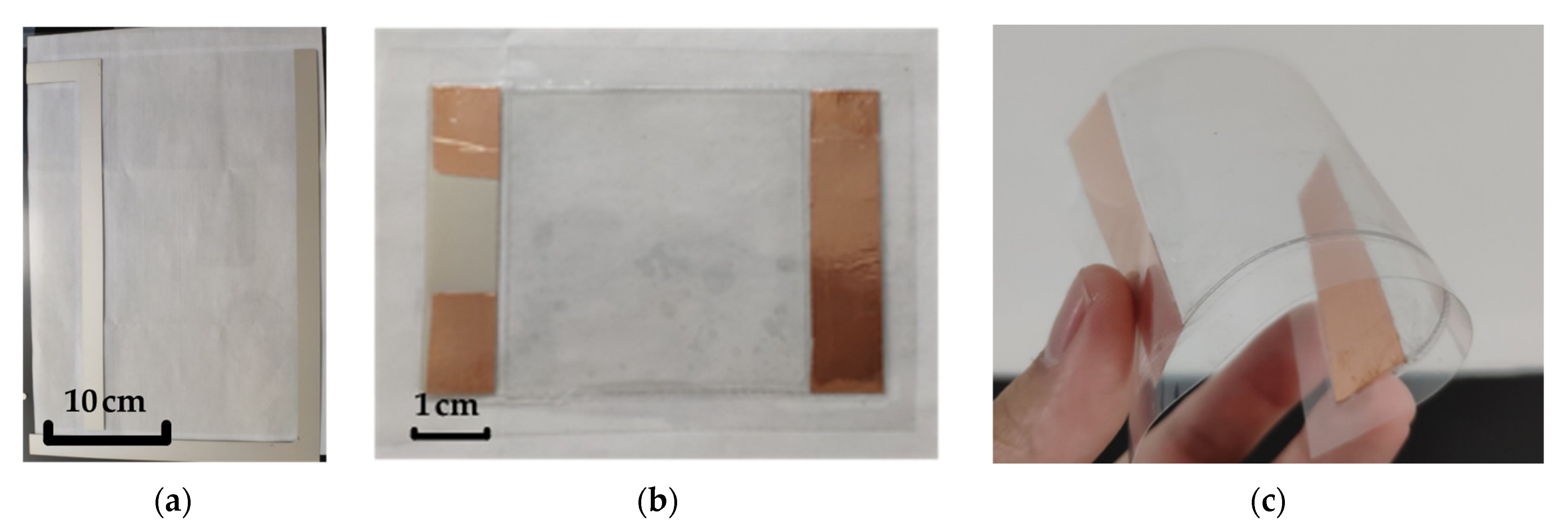

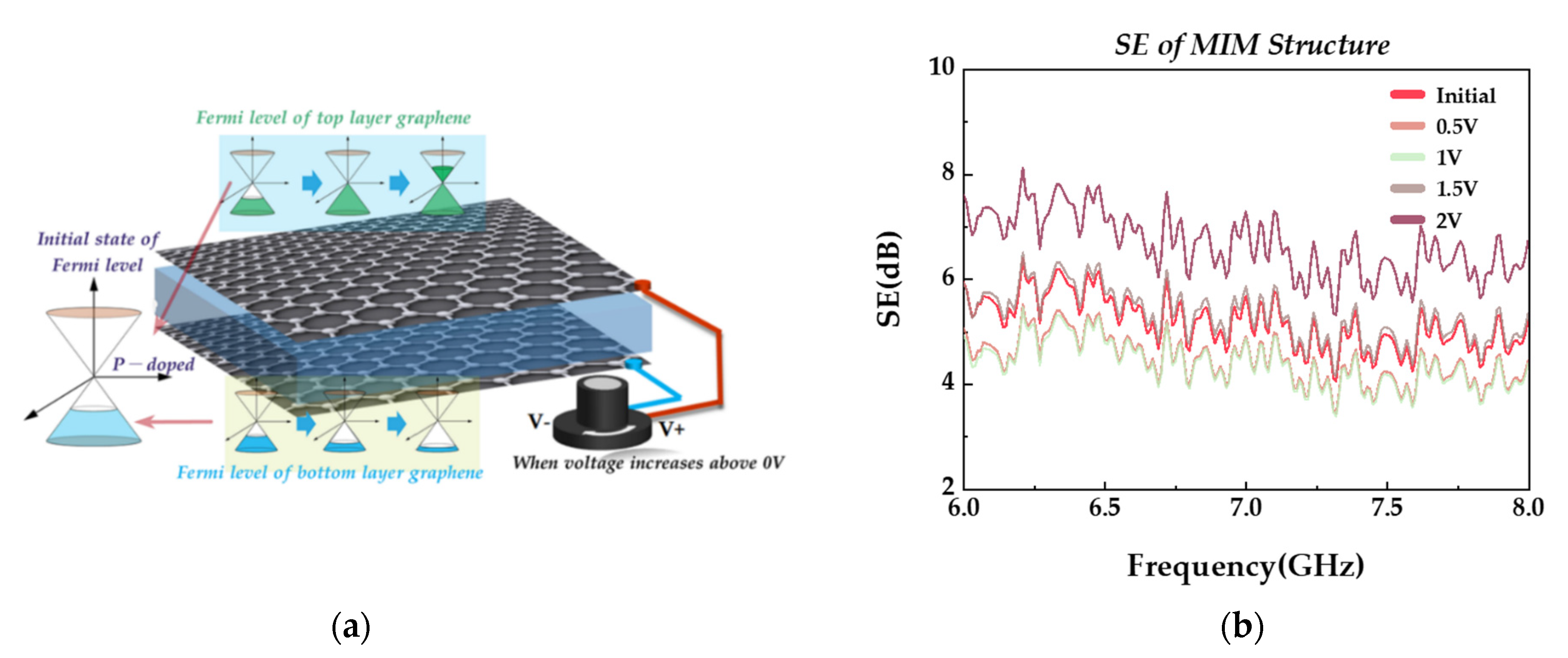

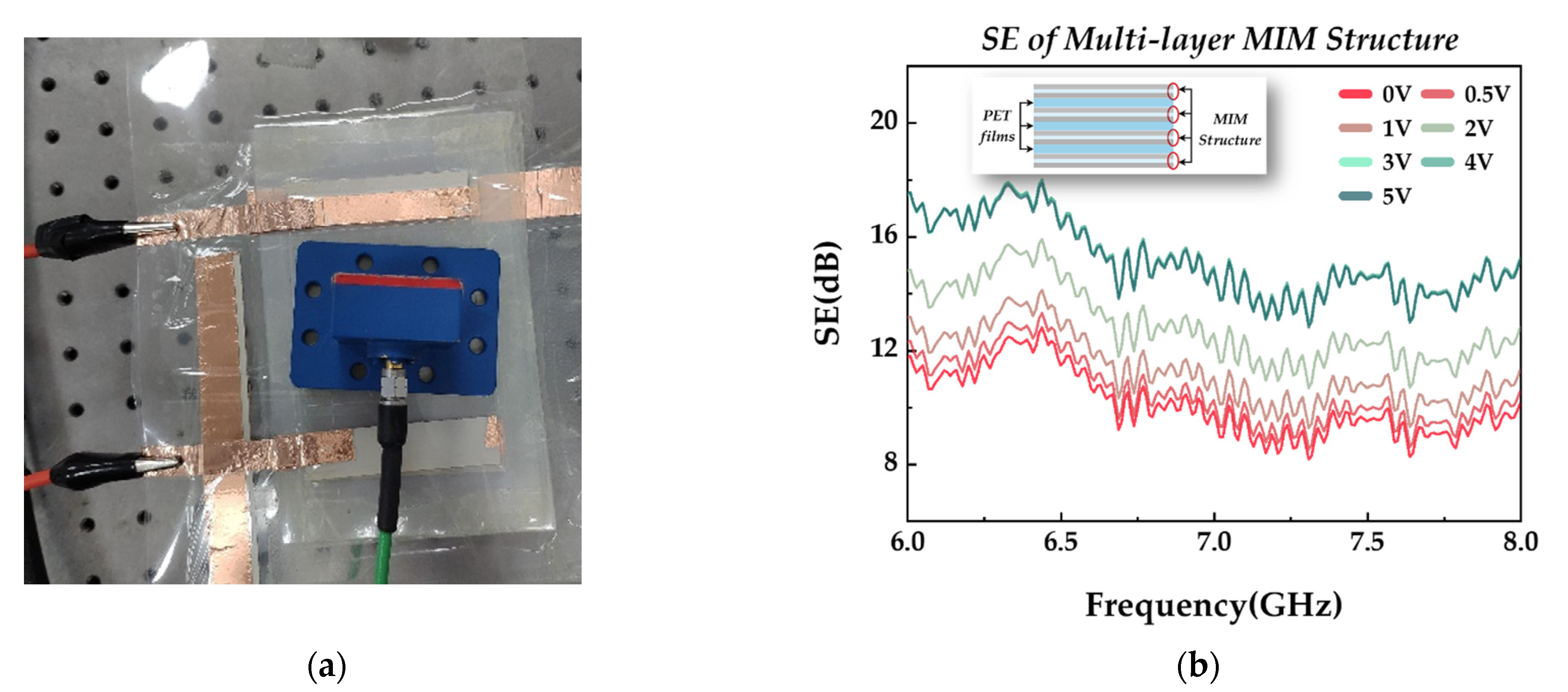
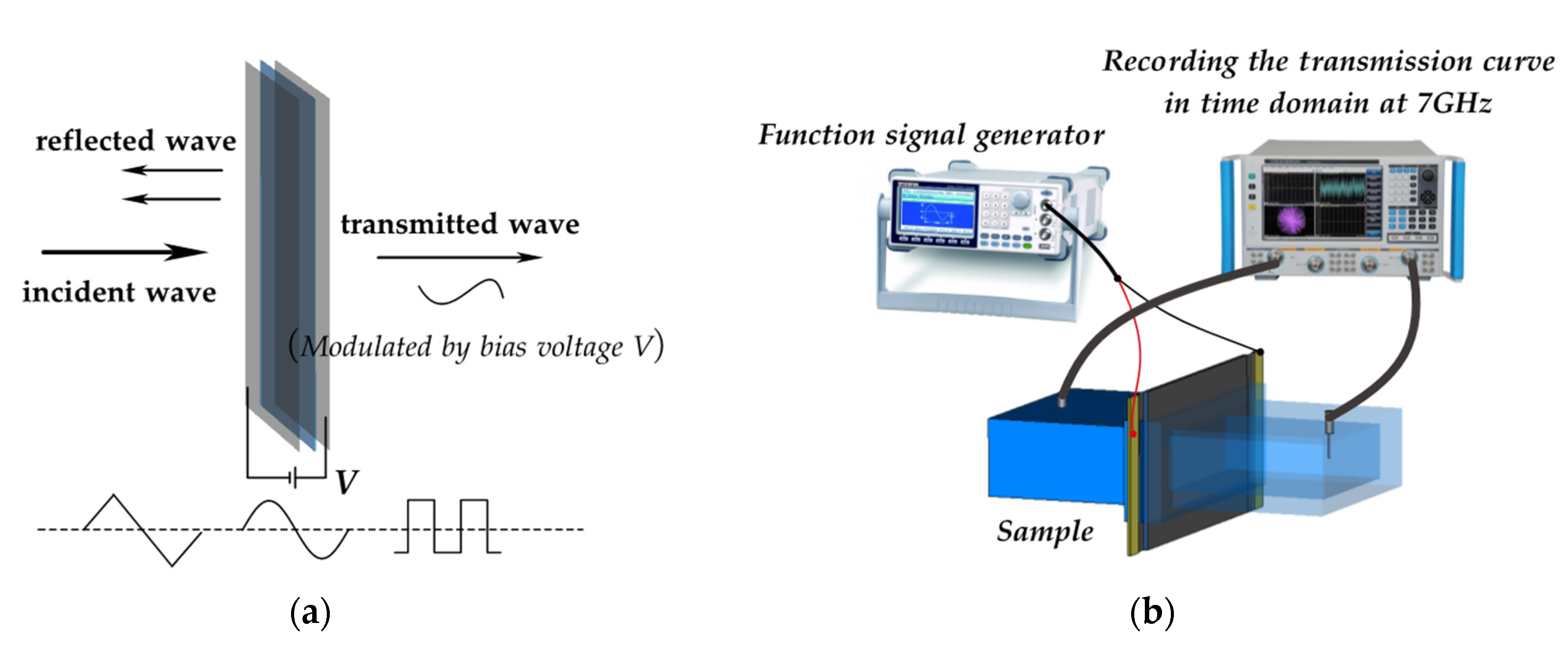
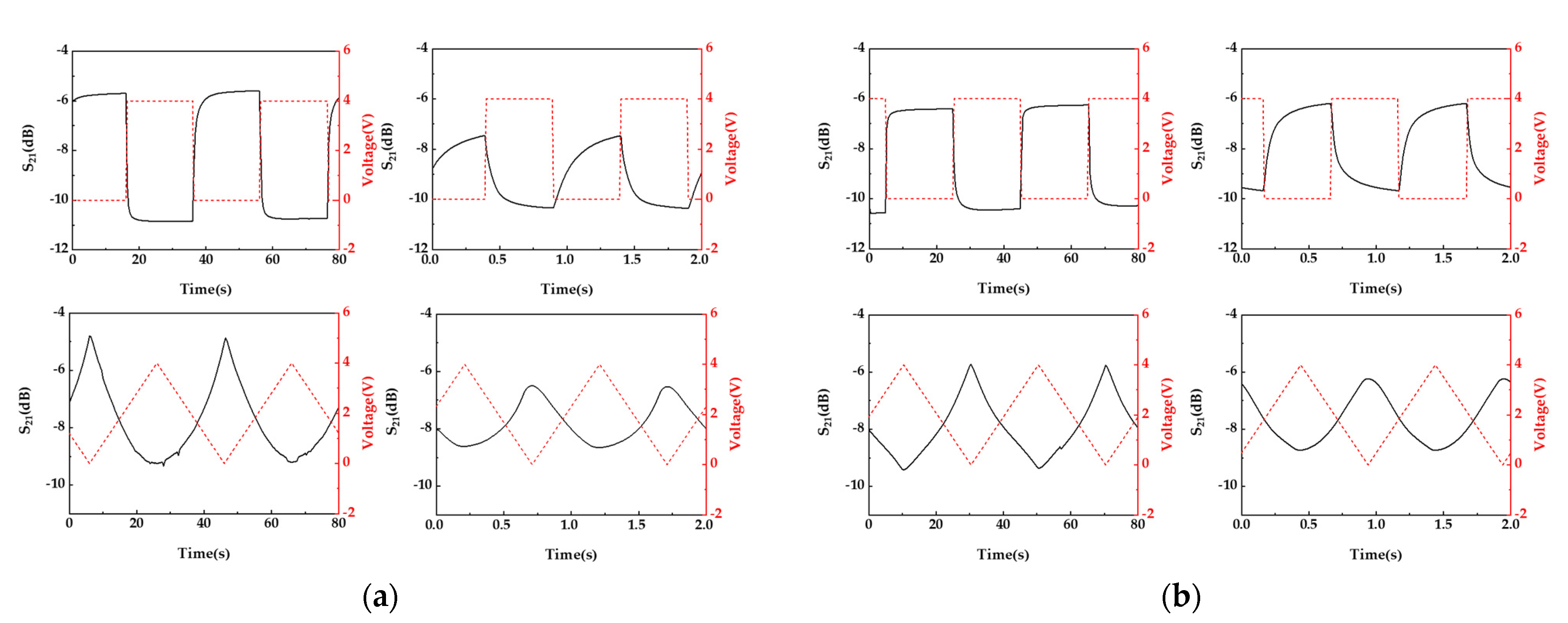
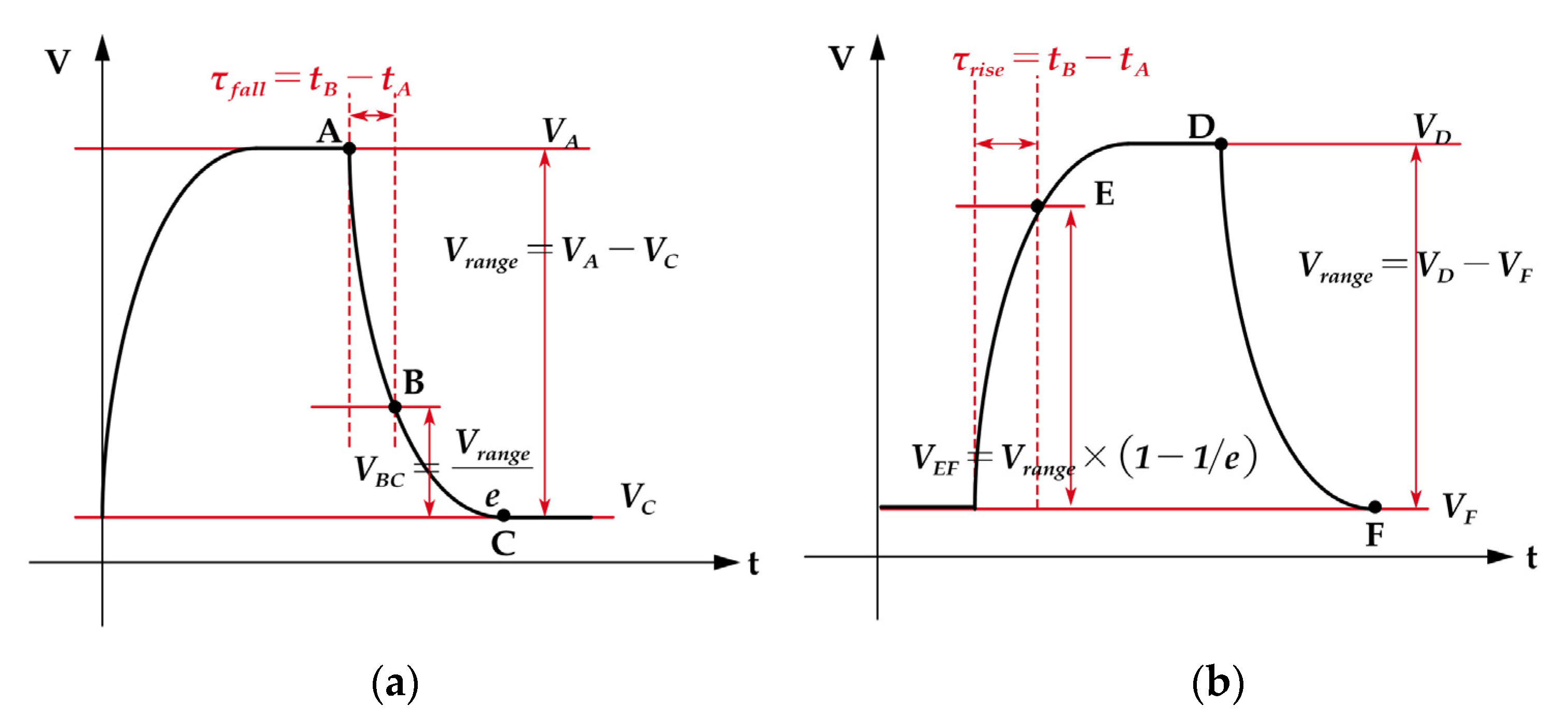

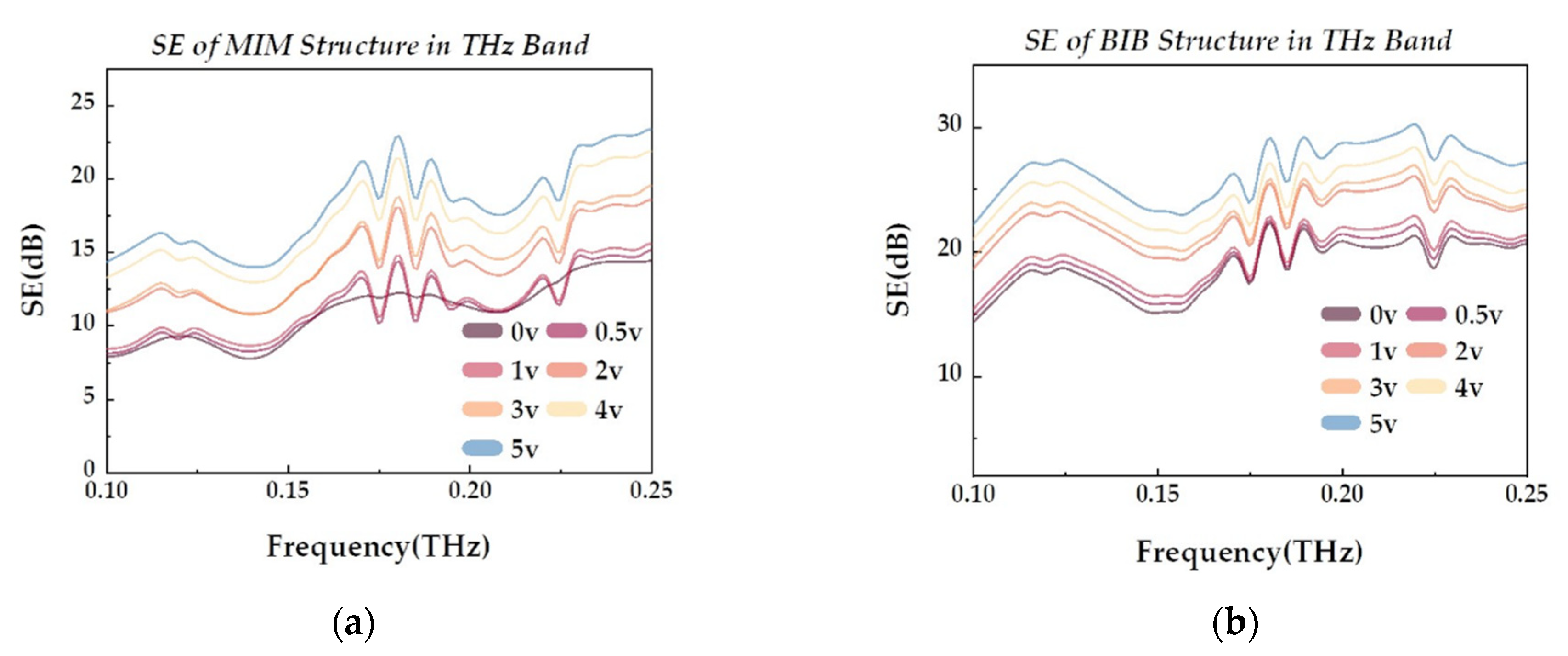
| MIM structure | 0.578 s | 1.006 s |
| BIB structure | 0.654 s | 0.859 s |
Publisher’s Note: MDPI stays neutral with regard to jurisdictional claims in published maps and institutional affiliations. |
© 2021 by the authors. Licensee MDPI, Basel, Switzerland. This article is an open access article distributed under the terms and conditions of the Creative Commons Attribution (CC BY) license (https://creativecommons.org/licenses/by/4.0/).
Share and Cite
Yao, L.; Liang, Y.; Wen, K.; Xu, Y.; Liu, J.; Liu, P.; Huang, X. Demonstration of Tunable Shielding Effectiveness in GHz and THz Bands for Flexible Graphene/Ion Gel/Graphene Film. Appl. Sci. 2021, 11, 5133. https://doi.org/10.3390/app11115133
Yao L, Liang Y, Wen K, Xu Y, Liu J, Liu P, Huang X. Demonstration of Tunable Shielding Effectiveness in GHz and THz Bands for Flexible Graphene/Ion Gel/Graphene Film. Applied Sciences. 2021; 11(11):5133. https://doi.org/10.3390/app11115133
Chicago/Turabian StyleYao, Lixiang, Yuanlong Liang, Kui Wen, Yanlin Xu, Jibin Liu, Peiguo Liu, and Xianjun Huang. 2021. "Demonstration of Tunable Shielding Effectiveness in GHz and THz Bands for Flexible Graphene/Ion Gel/Graphene Film" Applied Sciences 11, no. 11: 5133. https://doi.org/10.3390/app11115133






